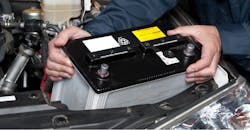Download this article in PDF format.
Many pundits believe that given the greater proliferation of more electronics in modern automobiles with each new model year, the decades-old, sealed lead-acid (SLA) 12-V car battery is being strapped to handle automotive power demands. Not only are more infotainment and safety electronic features being added every year, but when you include stricture emission and fuel-economy requirements, one can surmise that even the most efficient SLA battery in use today needs some help.
That said, the 12-V battery is here to stay, at least for the near term—i.e., the next few years. But it has its many drawbacks, including the fact that the lead element is hardly in vogue ecologically. And except for a few applications that need its heavy weight, the heavier higher-voltage batteries like 24 V or 36 V just weigh down the car further.
In fact, a 42-V auto battery system was proposed in the late 1990s in favor of 48 V to supplement the 12-V battery for automotive electrical power. The 48-V approach was deemed optimal in terms of fuel-efficiency savings, helping auto manufacturers meet emissions standards, and providing more power for the growing number of features desired by drivers to propel electric motors and electronic systems.
1. Hitachi’s 48-V lithium-ion battery pack, developed for mild-hybrid vehicles, features improved output and energy densities. It will work with conventional 12-V SLA batteries to meet the electric power demands of cars in the future.
The 48-V supplement to a 12-V battery has been demonstrated to be a better approach by Controlled Power Technologies, which is part of the advanced diesel-electric powertrain (ADEPT) consortium. The consortium’s aim is to develop 48-V intelligent electrification using an advanced lead-carbon battery.
Controlled Power Technologies uses its SpeedStart switched-reluctance motor-generator it developed for 48-V electrification. It takes advantage of energy harvesting, recycling of kinetic energy, and energy harvesting and recycling of kinetic and thermal energy developed from a car.
“Our SpeedStart motor-generator replaces the conventional alternator and starter motor and can instantaneously boost engine power and torque whenever required without having to feed additional fuel into the engine” says Nick Pascoe, Controlled Power Technologies co-founder and CEO, in an interview had last year with Dr. Peter Harrop of market research firm IDTechEx. “Not only can we boost vehicle performance and fuel economy, but we can also improve air quality by reducing carbon monoxide and particulate emissions. And while our SpeedStart also recovers kinetic energy, our turbine integrated gas energy recovery system TIGERS simultaneously recovers thermal energy.”
Going Mild
In 2011, several German auto manufacturers introduced cars with on-board 48-V systems known as mild hybrids. This mild 48-V electrical system is emerging as the next revolution in cars.
Over the last few decades, auto manufacturers have been thinking about ways to address the need for more electrification via higher voltages. And what is emerging a mild-hybrid lithium-ion battery that supplements the 12-V SLA battery.
Along those lines, Hitachi Automotive Systems developed an advanced lithium-ion 48-V battery pack (Fig. 1) for mild hybrids by combining its battery-management system technology with its strengths in Li-ion cell manufacturing technology. The pack increases output density 1.25X and provides 1.5X the energy density compared with existing level Li-ion 48-V batteries developed last year.
At a weight of 8 kg (17.6 lbs), the mild hybrid is not much heavier than existing 12-V batteries, and it is comparatively smaller at 6.985 in. (175 mm) wide, 11.82 in. (300 mm) long, and 3.546 in. (90 mm) high. Hitachi is sampling this battery pack now and expects to mass-produce it by fiscal year 2020.
2. This prototype of a sub-1-kWh Li-ion battery pack (black box left) sends electricity to a small 12-V SLA battery via a trunk-mounted dc-dc converter (the silver box with a fan), which steps down the voltage to power the car’s 12-V accessories. In a production model, they’d likely be tucked away, possibly against the back of the rear bench, over to the side, or even under a tray. (Source: Delphi and Continental)
The demand for mild-hybrid Li-ion 48-V batteries is rapidly growing, particularly in Europe and Asia, according to an IHS study. Automotive experts believe that by 2025, one fifth of all cars sold around the worldwide will have some sort of 48-V technology for power.
At this year’s Consumer Electronics Show, Delphi Automotive and Continental showed off a 48- 48-V, sub-1-kWh, Li-ion battery (Fig. 2). Together with a dc- dc converter, fuses, and a battery controller, they require little space.
About the Author
Roger Allan
Roger Allan is an electronics journalism veteran, and served as Electronic Design's Executive Editor for 15 of those years. He has covered just about every technology beat from semiconductors, components, packaging and power devices, to communications, test and measurement, automotive electronics, robotics, medical electronics, military electronics, robotics, and industrial electronics. His specialties include MEMS and nanoelectronics technologies. He is a contributor to the McGraw Hill Annual Encyclopedia of Science and Technology. He is also a Life Senior Member of the IEEE and holds a BSEE from New York University's School of Engineering and Science. Roger has worked for major electronics magazines besides Electronic Design, including the IEEE Spectrum, Electronics, EDN, Electronic Products, and the British New Scientist. He also has working experience in the electronics industry as a design engineer in filters, power supplies and control systems.
After his retirement from Electronic Design Magazine, He has been extensively contributing articles for Penton’s Electronic Design, Power Electronics Technology, Energy Efficiency and Technology (EE&T) and Microwaves RF Magazine, covering all of the aforementioned electronics segments as well as energy efficiency, harvesting and related technologies. He has also contributed articles to other electronics technology magazines worldwide.
He is a “jack of all trades and a master in leading-edge technologies” like MEMS, nanolectronics, autonomous vehicles, artificial intelligence, military electronics, biometrics, implantable medical devices, and energy harvesting and related technologies.



